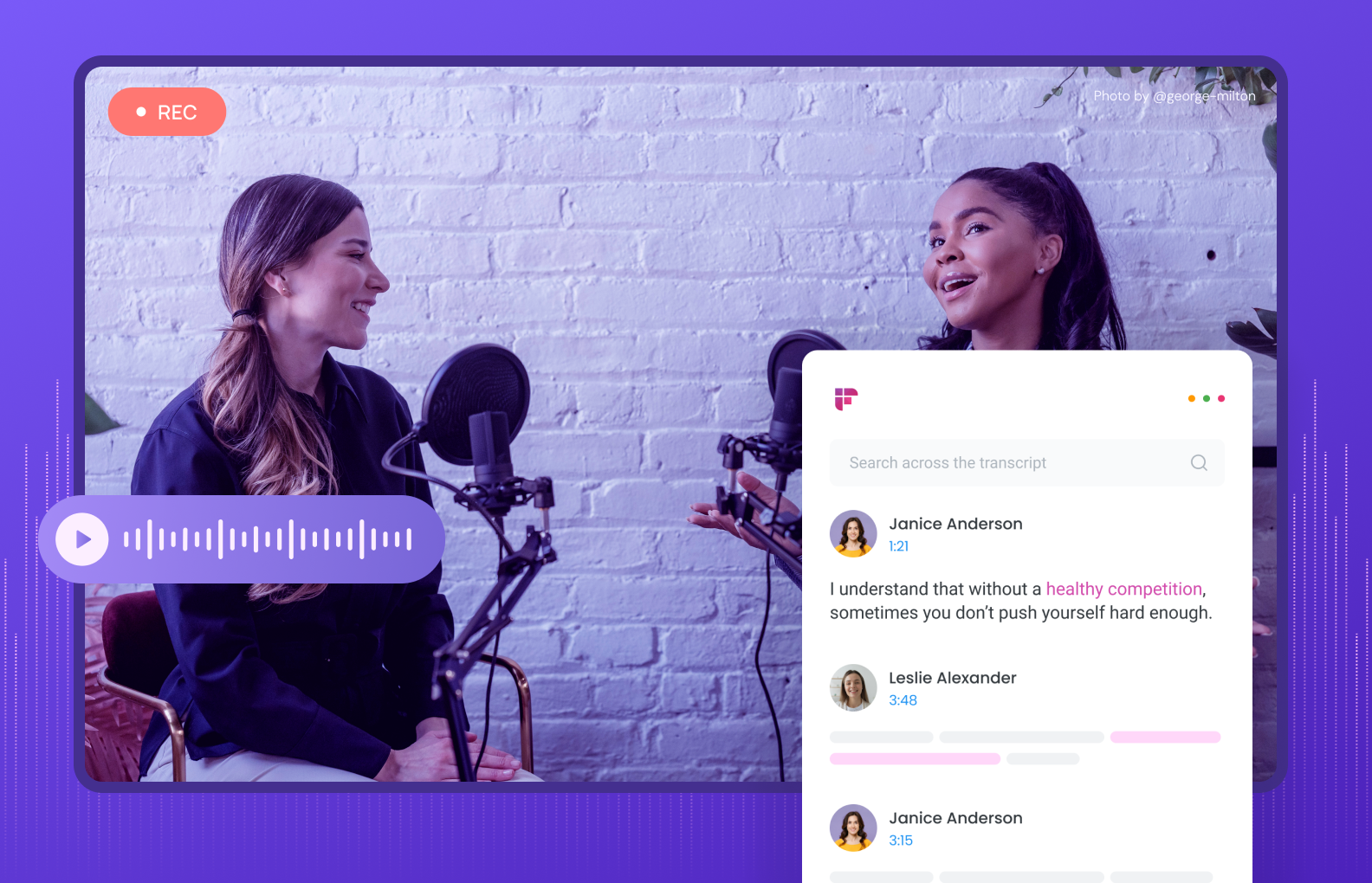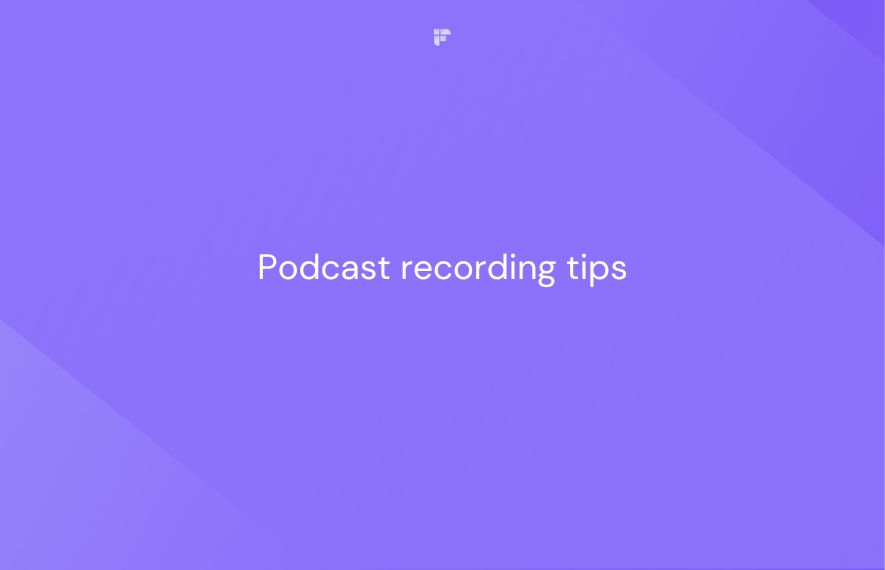Recording a podcast is easier said than done. From choosing the right equipment to editing your audio, there are a lot of moving parts to consider.
That's why we've compiled 22 podcast recording tips to help streamline your podcasting process and produce high-quality content.
So grab your headphones and get ready to master these game-changing techniques for crystal-clear recordings right from the get-go.

22 podcast recording tips
The Podcast Index predicts there are roughly 4 million podcasts in the US alone. So, how can you cut through the noise and make your next show stand out? Simple—by following these 22 podcast recording tips.
These valuable suggestions will help you bypass the learning curve and create the best podcasts.
1. Invest in the best equipment
Whether you're a seasoned podcaster or just starting, one thing is for sure: audio quality is key. If your audio quality is poor, listeners will likely switch off and never return, no matter how great your content is.
Invest in a quality microphone, a pop filter, and a suitable pair of headphones to significantly improve your audio quality. Good equipment can make all the difference in your podcast's professional appeal.
Good quality equipment helps eliminate background noise and interference, producing a cleaner and more professional sound. Additionally, it saves time by reducing the need for post-production edits and adjustments.

2. Do not skip the warm-up ritual
Like a singer, warm up your vocal cords before diving into podcasting. Spend a few minutes practicing your script or reciting tongue twisters to loosen up your mouth and vocal cords, ensuring clear and confident speech.
3. Choose quiet corners
The next in our list of podcast recording tips is the location—where you choose to record the audio/video from.
Choose a small, quiet room for recording to minimize external noise and echoes. Close windows and doors, turn off noisy devices, and surround yourself with soft furnishings like couches, pillows, and carpets that absorb sound.
4. Begin with a noise profile pause
One of the podcast recording best practices you must follow is leaving a 5-second pause before you start talking.
A noise profile pause is a few seconds before you start recording. During the pause, you record the background noise. It helps your podcast editing software identify and remove any background noise or hum throughout your recording.
It is better if you record in an environment with ambient noise or use sensitive microphones that can pick up even the slightest background noise.
5. Position the microphone right
The right microphone placement can help capture clear and natural-sounding audio. Position your microphone at mouth level, use a pop filter, and maintain a consistent distance for optimal volume control.
Try different angles and distances to find the sweet spot for your voice. This will help you achieve a consistent sound across your episodes.
6. Stay vigilant of volume levels
Monitor volume levels while recording. You can use your recording software’s volume meters. Aim to keep your voice within the green and yellow sections for a normal conversational tone and louder emphasis, avoiding the red zone to prevent distortion.
7. Control your breathing
The next in line for tips to record a podcast is your breathing. Heavy breathing and sighs can impact the clarity and overall quality of your recording.
However, breathing is a natural process, and it can be challenging to control it consciously while recording. So, to control your breathing pattern, take deep breaths before recording and exhale slowly. It helps to calm your nerves and relax your body, making it easier to control your breathing during the recording process.
Another technique is to practice breathing exercises, such as diaphragmatic breathing, which helps to control your breath and reduce the likelihood of unwanted sounds.
To do this, breathe deeply through your nose. Allow your belly to expand. Then exhale slowly through your mouth. Repeat this process several times before recording to help regulate your breathing.
Also, sit up straight, take smaller breaths, or move away from the mic when necessary.
8. Minimize body movements
Body movements can create unwanted noise, such as rustling or tapping sounds, which can distract your listeners and detract from the clarity and professionalism of your podcast.
When recording a podcast, finding a comfortable and stable position to minimize body movements is important.
Sit or stand in a stable position and avoid fidgeting or moving excessively during the recording process. This can reduce unwanted noise and ensure that your listeners can focus on the content of your podcast.
Another way to minimize body movements is to use a shock mount or a boom arm for your microphone. These tools stabilize the microphone and reduce unwanted noise caused by accidental bumps or movements.
Be mindful of your clothing and accessories when recording a podcast. Avoid wearing clothing that rustles or jingles, such as jewelry or loose-fitting clothing, and remove any items that could create unwanted noise, such as keychains or bracelets.
9. Test before recording
Test your recording setup and audio levels before starting your episode. Address any audio issues immediately or postpone recording to avoid discovering problems later on that can't be fixed in editing.
By testing beforehand, you can familiarize yourself with the recording process and reduce any potential nerves or anxiety about recording.
10. Use headphones
Use headphones to avoid audio feedback and monitor your voice during recording.
Headphones allow you to monitor the audio quality of your recording in real-time, enabling you to adjust the recording settings as needed.
This is particularly important when recording with guests or co-hosts, as it lets you hear their audio quality and ensure everyone sounds clear and balanced.
It also helps you to stay focused and engaged during the recording process.
11. Limit interruptions
Interruptions can come in many forms, such as background noise, phone calls, notifications, or interruptions from others in the room. These interruptions can create distractions and detract from the focus and clarity of the podcast, making it harder for listeners to follow along and engage with the content.
Podcast recording best practices involve limiting these interruptions to a minimum.
Turn off any notifications or devices that could create distractions during the recording process, such as your phone, computer, or television.
Also, resist the urge to interject while your guest speaks. Practice active listening and waiting for natural breaks in the conversation to add your thoughts.
12. Make audio cues for mistakes
The most valuable and least used tip for recording podcasts is making a cue to locate mistakes in your track.
Use a spoken marker, a pause, or a high-pitch sound marker like a dog clicker. This will make it easier to find and edit out mistakes during post-production.
13. Mute yourself when not speaking
Even small noises, such as breathing or shuffling papers, can be picked up by the microphone. It can spoil the listening experience for your audience.
So, mute yourself when you aren't speaking. It will eliminate any background noise or distractions that could detract from your podcast's quality and professionalism.
This way, your podcasts are more engaging and enjoyable for your audience.
14. Use balanced effects
Use sound effects and music sparingly. While music and sound effects can enhance your show, having too much of it can make your shows sound overproduced or unprofessional.
Balance these effects to create a natural and polished podcast.
15. Stay hydrated
Another in the list of podcast recording tips is to stay hydrated before, during, and after recording the podcast.
When dehydrated, your vocal cords can feel dry and irritated, leading to a hoarse or strained voice.
Drinking enough water before and during the recording hydrates vocal cords and reduces the risk of vocal strain or fatigue. It will make your voice sound clear and ensure you can maintain a consistent energy level.
Also, leave a bottle of water with your guests.
16. Record speakers on different channels
One of the most useful podcast recording tips is using different channels for different speakers. It improves the quality and flexibility of your podcast.
Recording each speaker on a separate channel gives you greater control over the volume and balance of each speaker's voice. This can be especially useful when editing the podcast.
Using different channels allows you to independently adjust the volume of each speaker's voice, ensuring that each person is heard clearly and consistently.
17. Make blanket forts to enhance your environment
If you're in a noisy environment, drape a blanket over yourself and your microphone to reduce background noise. This makeshift solution may not be glamorous, but it's effective when recording in busy hotels, cars, or apartment buildings.
18. Take breaks
Divide your podcast into segments with logical breaks. Use these moments to check your audio, hydrate, stretch, or discuss the next segment with your guest or co-host. Breaks help maintain your energy and focus throughout the recording session.
19. Use the best internet
For remote interviews or conversations, boost your internet connection to improve audio quality. Connect directly to your router, close unnecessary apps, and ensure your guest has a strong connection too. Aim for an internet speed of at least 25 Mbps for optimal performance.

20. Trust your instincts
While you can use several technical tools and software to analyze and enhance your audio, your ears are still the best tool at your disposal when assessing the overall quality of the recording.
Listen to your recordings carefully and trust your instincts when something sounds off. Take notes on your ideal recording setup and strive to replicate it for consistent sound quality across episodes.
21. Curate the content carefully
While great audio quality is crucial, it's equally important to create engaging content. Focus on developing interesting topics, storytelling, and conversations that will captivate your listeners and keep them coming back for more.
22. Record and transcribe
Consider recording and transcribing your podcast to expand your reach and accessibility. Some people prefer to read along while they listen or may have hearing impairments that make it difficult to understand the audio.
Apart from improving your podcast's SEO, transcripts also make it easier to repurpose your content for blog posts, social media, or other forms of content marketing.

Use an automated transcription software like Fireflies to transcribe your recordings and create podcast transcripts in no time. It also helps you effortlessly create soundbites from your podcast that you further use to market your content on social media as shorts and reels.
In conclusion
There you have it: 22 podcast recording tips to take your podcasting game from drab to fab.
Invest in quality equipment, choose a quiet recording space, limit interruptions, add pauses, take breaks, and always test before you record. But before all, be sure you have the most relevant and interesting topic for the podcast.
Once ready, go forth and podcast like nobody's listening. Who knows, you'll be the next big thing in the world of podcasting. Cheers!







